لقد ولت الأيام التي كان العملاء يكتفون فيها بشراء المنتجات أو الخدمات فقط. فهم يتوقون في الوقت الحاضر إلى التجارب الشخصية والعلاقات الهادفة والدعم الاستثنائي.
لكي تزدهر في هذا العصر الذي يركز على العملاء، يجب أن تتبنى نهج استراتيجي لإدارة علاقات العملاء - وهنا يأتي دور استراتيجية إدارة علاقات العملاء (CRM).
في هذه المقالة، سنستكشف 10 استراتيجيات قوية لإدارة علاقات العملاء (CRM) لاستخدامها في عملك حتى تتمكن من رفع مستوى تجربة العملاء، وبناء ولاء العملاء، وتحقيق النمو المستدام. لننطلق! 💪
ما هي استراتيجية إدارة علاقات العملاء؟
استراتيجية إدارة علاقات العملاء هي خطة مركزة (أو مجموعة من الإجراءات) تقوم بإنشائها لإدارة علاقاتك مع العملاء بفعالية. بالإضافة إلى ذلك، فإن استراتيجية إدارة علاقات العملاء الناجحة تتضمن استخدام أداة إدارة علاقات العملاء والعمليات التي تركز على العملاء لجمع وتحليل المعلومات القيمة عن عملائك.

باستخدام ميزة إدارة علاقات العملاء في ClickUp، يمكنك بسهولة تتبع بيانات العملاء
يمكن أن تتضمن هذه المعلومات بياناتهم الديموغرافية، وتاريخ الشراء، وتفضيلات التواصل، وغير ذلك. من خلال تحليل هذه البيانات، يمكنك الحصول على رؤى عميقة حول احتياجات عملائك.
ومن ثم يمكنك تخصيص منتجاتك وخدماتك واتصالاتك لتلبية تلك الاحتياجات بشكل أفضل. ✨
فوائد استراتيجية إدارة علاقات العملاء الفعالة
دعنا نتعمق في أهم الفوائد الرئيسية لامتلاك استراتيجية فعالة لإدارة علاقات العملاء لعملك. سيساعدك فهم هذه الفوائد على إدراك سبب كون إدارة علاقات العملاء أفضل شيء يمكنك القيام به من أجل دفع نمو الأعمال التجارية .
1. زيادة الاحتفاظ بعملائك
تساعدك استراتيجية إدارة علاقات العملاء الفعالة على بناء علاقات أقوى مع عملائك. عندما تجمع بيانات العملاء وتحللها وتديرها، فإنك تفهم سلوكياتهم واحتياجاتهم وتفضيلاتهم بشكل أفضل. تتيح لك هذه المعرفة تخصيص تفاعلات العملاء، وتقديم حلول مخصصة، وإنشاء تجارب من الدرجة الأولى تجعل العملاء يعودون إليك مرة أخرى.
2. صمم حملات تسويقية مستهدفة
عندما تستخدم نظام إدارة علاقات العملاء لجمع بيانات العملاء وتخزينها، يمكنك تقسيم قاعدة عملائك وإنشاء حملات تسويقية مستهدفة. من خلال تخصيص الرسائل والعروض التسويقية لشرائح محددة من العملاء، يمكنك تحسين ملاءمتها وفعاليتها. وهذا يؤدي إلى معدلات استجابة أعلى، وزيادة توليد العملاء المحتملين، وتحسين العائد على الاستثمار لجهودك التسويقية. 📈
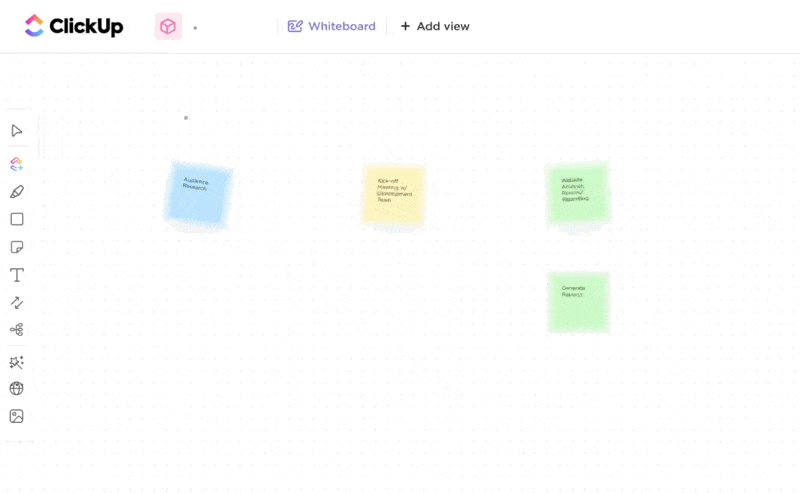
ClickUp Whiteboards هي مركزك المركزي المرئي لتحويل أفكار الفريق إلى إجراءات منسقة بشكل تعاوني
3. تبسيط عمليات عملك
تساعد استراتيجية إدارة علاقات العملاء على تبسيط عملياتك التجارية. من خلال جعل بيانات العملاء مركزية, أتمتة المهام المتكررة ودمج الأنظمة المختلفة، يمكنك تعزيز الإنتاجية والكفاءة. يتيح ذلك لفريقك التركيز على الأنشطة عالية القيمة مثل تقديم تجارب عملاء استثنائية وزيادة معدلات التحويل.
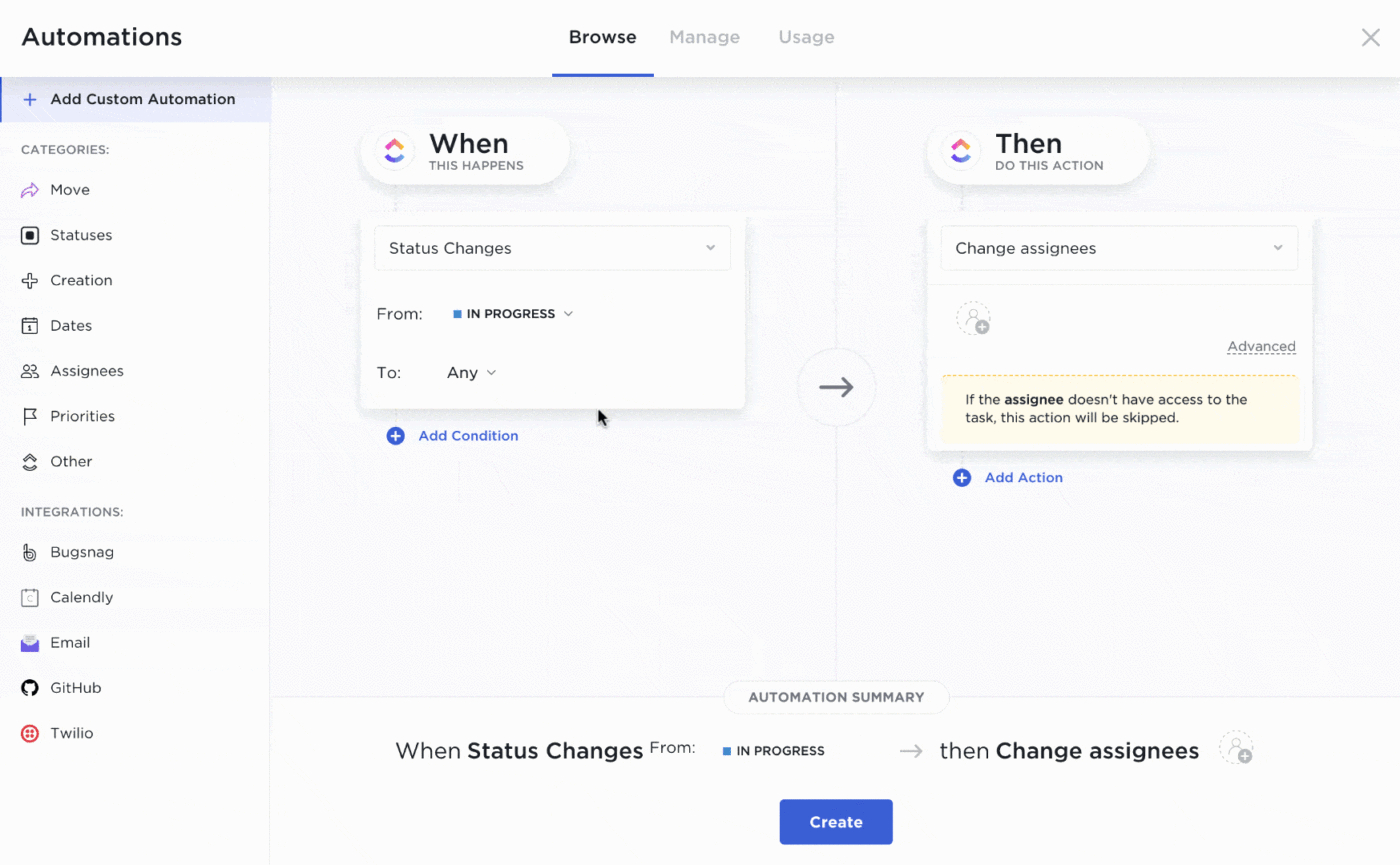
استخدم وصفات الأتمتة المُنشأة مسبقًا في ClickUp أو قم بتخصيصها بناءً على احتياجاتك، حتى يتمكن فريقك من التركيز على ما هو أكثر أهمية
4. اكتساب ميزة تنافسية
يعني تنفيذ استراتيجية إدارة علاقات العملاء تقديم تجارب شخصية وخدمة عملاء ممتازة ومشاركة استباقية. هذه العوامل تميزك عن الآخرين في السوق، مما يمنحك ميزة تنافسية. ونتيجة لذلك، فإنك تجذب عملاء جدد، وتعزز ولاء العملاء الحاليين، وتضع علامتك التجارية في مكانة رائدة تركز على العملاء.
5. تعزيز المبيعات والإيرادات
كما ناقشنا سابقًا، تؤثر استراتيجية إدارة علاقات العملاء تأثيرًا مباشرًا على عوامل مثل إنتاجية فريق العمل، والاحتفاظ بالعملاء، وتحويلات الحملات التسويقية - وكلها تعمل معًا لتعزيز مبيعات شركتك وإيراداتها بشكل كبير. 💰
## 10 استراتيجيات لإدارة علاقات العملاء لأعمالك التجارية
لكي تظل أعمالك قادرة على المنافسة والنجاح على المدى الطويل، لم يعد بناء العلاقات مع العملاء أمرًا اختياريًا - بل أصبح ضرورة. استخدم أفضل 10 استراتيجيات لإدارة علاقات العملاء هذه لتظهر لعملائك أنك موجود من أجلهم ... في كل خطوة على الطريق!
1. تقييم عمليات إدارة علاقات العملاء الحالية
إذا كان لدى شركتك عملاء يدفعون المال، فمن المحتمل أن يكون لديها بعض عمليات إدارة علاقات العملاء التي تعمل بشكل جيد (وربما يمكن تحسينها أكثر). في الوقت نفسه، قد تكون هناك اختناقات أو أوجه قصور أو نقاط ضعف قد تعيق رضا العملاء.
على سبيل المثال، هل هناك تأخيرات في الرد على استفسارات العملاء؟ هل لديك حاليًا برنامج إدارة علاقات العملاء وإدارة المشاريع مما يجعل من الصعب تتبع تفاعلات العملاء؟ 👀

إنشاء نماذج أكثر ذكاءً في ClickUp باستخدام المنطق الشرطي لتبسيط العملية - بغض النظر عن مدى تعقيدها
يمكنك التواصل مع عملائك من خلال الاستبيانات، ومجموعات التركيز، و نماذج المنطق الشرطي لجمع ملاحظاتهم. بالإضافة إلى ذلك، قم بإشراك فريقك في عملية التقييم - سيكون لديهم مدخلات قيمة من إدارة العمليات الداخلية والتفاعل مع العملاء.
ستوفر التعليقات التي تجمعها رؤى قيمة حول نقاط قوتك ومجالات التحسين. وسيسمح لك الحصول على هذه المعلومات ببناء نظام محسن سير عمل إدارة علاقات العملاء يخدم عملاءك بشكل أفضل. جرّب إدارة علاقات العملاء في ClickUp
2. وضع أهداف واضحة لإدارة علاقات العملاء ومؤشرات الأداء الرئيسية
قبل أن تحدد أهداف إدارة علاقات العملاء لفريقك، أعد النظر في استراتيجية عملك وأهداف عملك طويلة الأجل - فكر فيما تريد تحقيقه وكيف يمكن لأهداف إدارة علاقات العملاء دعم هذه الأهداف.
على سبيل المثال، إذا كنت تهدف إلى مضاعفة إيراداتك، فقد تتمحور أهداف إدارة علاقات العملاء حول تحسين الاحتفاظ بالعملاء أو تعزيز فرص البيع المتبادل والبيع المتبادل. قم بتقييم تأثير كل هدف من أهداف إدارة علاقات العملاء على أهداف عملك لتحديد أهداف إدارة علاقات العملاء التي يجب معالجتها أولاً. 🛠️
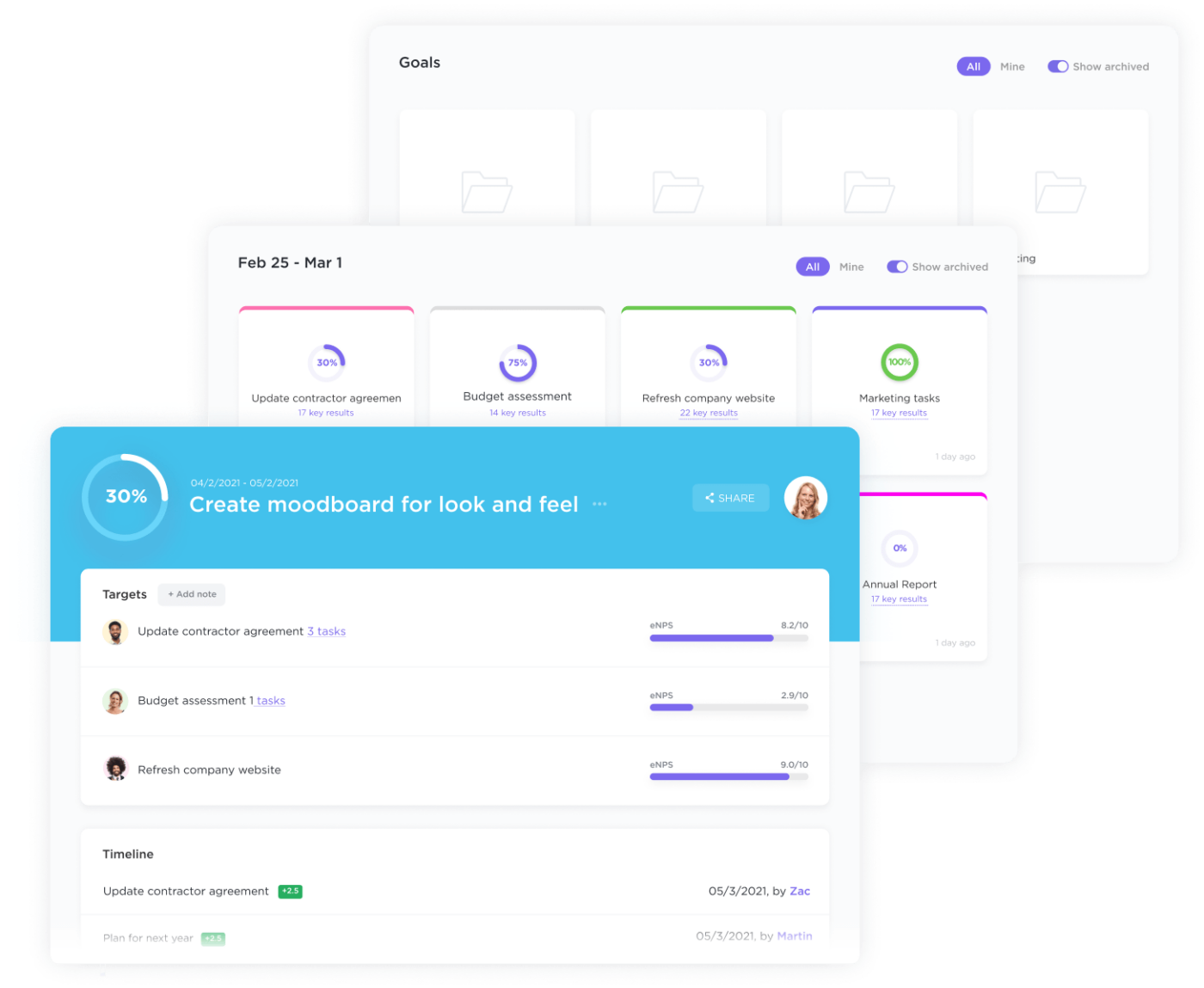
ابقَ على المسار الصحيح لتحقيق أهدافك من خلال جداول زمنية واضحة وأهداف قابلة للقياس وتتبع التقدم التلقائي
بالإضافة إلى ذلك، تأكد من أن أهداف إدارة علاقات العملاء الخاصة بك مدعومة بما يلي مؤشرات الأداء الرئيسية (مؤشرات الأداء الرئيسية). لنفترض أن هدفك هو تحسين زمن الاستجابة - في هذه الحالة، يمكن أن يكون مؤشر الأداء الرئيسي المحدد والقابل للقياس هو تقليل متوسط زمن الاستجابة لاستفسارات العملاء من ثلاثة أيام إلى يوم واحد خلال الأشهر الثلاثة القادمة.
وهذا يجعل من السهل تتبع التقدم المحرز وتقييم فعالية استراتيجية إدارة علاقات العملاء ورحلة العميل بشكل عام.
3. حدد عميلك المثالي
لزيادة فعالية رحلة عميلك إلى أقصى حد، عليك أن تكتسب فهمًا عميقًا لجمهورك المستهدف و إنشاء شخصيات فعالة للمستخدمين (المعروف أيضًا باسم شخصيات المشترين أو ملفات تعريف العملاء).
ابدأ بإجراء بحث شامل لفهم جمهورك المستهدف. يمكن أن يشمل ذلك أبحاث السوق، وتحليل بيانات العملاء، وإجراء استطلاعات الرأي في أداة إدارة علاقات العملاء الخاصة بك.
ابحث عن الأنماط والقواسم المشتركة التي تظهر من هذا البحث، مثل التركيبة السكانية والسلوكيات ونقاط الألم والدوافع.
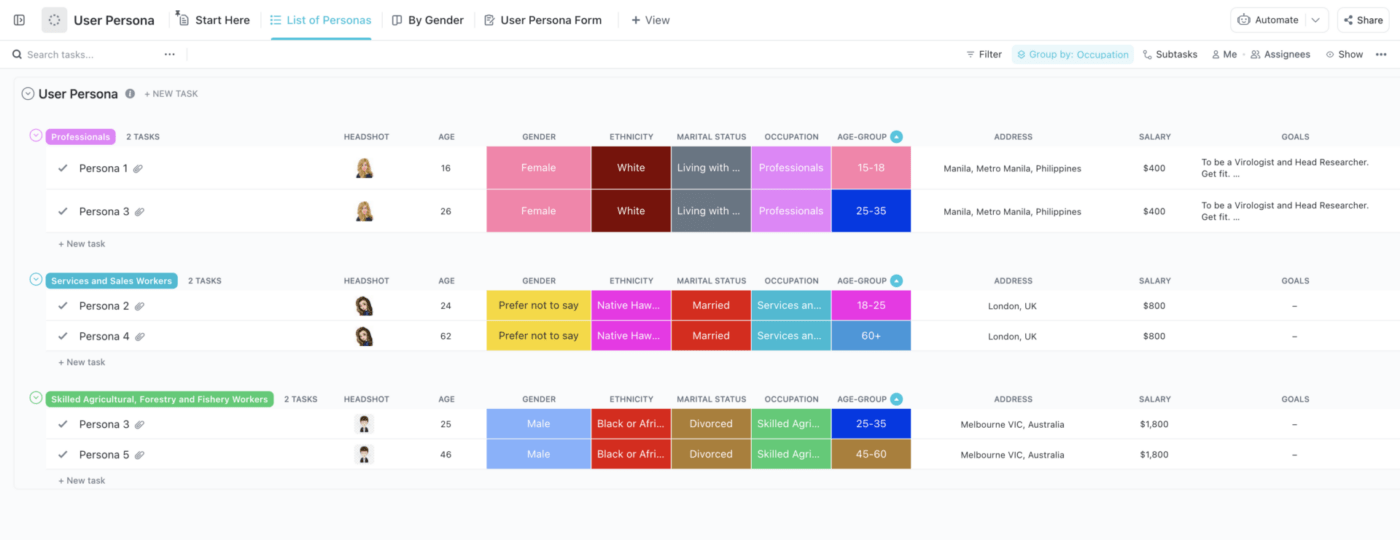
اعرض المعلومات الأساسية عن جمهورك المستهدف بما في ذلك دوافعهم وخصائصهم السكانية وتاريخهم المهني باستخدام قالب شخصية المستخدم من ClickUp
قم بتلخيص هذه التفاصيل في شخصيات متعددة باستخدام قالب شخصية المستخدم في ClickUp -كل منها يمثل شريحة مميزة من عملائك المثاليين. هذه قوالب شخصية المستخدم ستوجه إستراتيجية إدارة علاقات العملاء الخاصة بك وتساعدك على تخصيص اتصالاتك وحملاتك التسويقية و عروض المنتجات لتتوافق بشكل أفضل مع جمهورك المستهدف. 🤩
4. إنشاء تجارب مخصصة للعملاء
لإنشاء تجارب مخصصة، تحتاج إلى فهم عميلك المستهدف بعمق (كما هو موضح في الاستراتيجية السابقة) وأيضًا أين هم في رحلتهم.
تشير رحلات العميل إلى نقاط الاتصال والتفاعلات المختلفة التي يمر بها العميل مع نشاطك التجاري خلال عملية الشراء. يمكنك بسهولة رسم خريطة لرحلات العملاء الفريدة في نشاطك التجاري باستخدام أي مما يلي قوالب رحلة العميل .
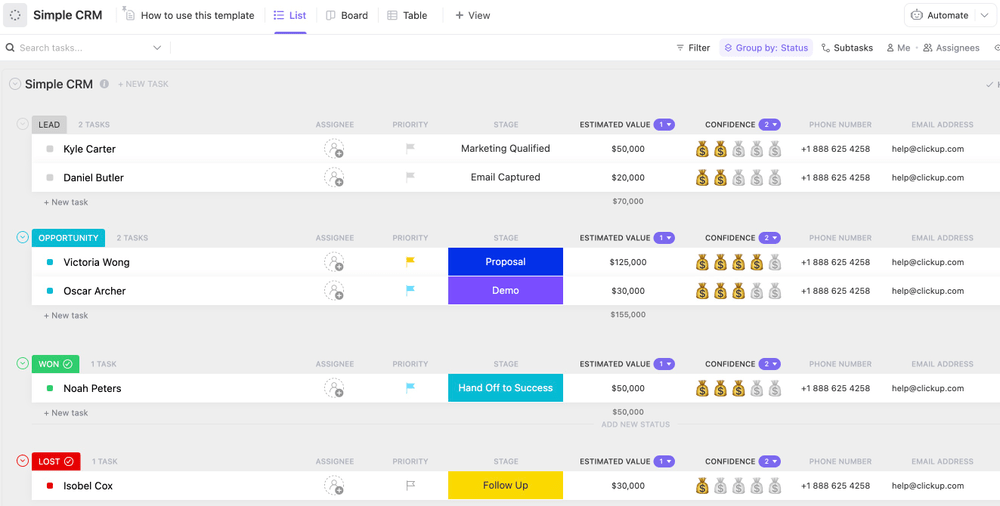
تتبع مكان عملائك في رحلتهم مع ClickUp
من خلال تخطيط هذه الرحلات المحتملة، يمكنك تحديد فرص التخصيص. ابدأ بتحديد المراحل النموذجية التي يمر بها عملاؤك، مثل الوعي والنظر في الأمر واتخاذ القرار وما بعد الشراء في قالب إدارة علاقات العملاء البسيط من ClickUp .
ثم قم بتقسيم كل مرحلة إلى نقاط اتصال وإجراءات محددة خاصة بنشاطك التجاري. بالتسلح بهذه الرؤى، يمكنك تخصيص تفاعلاتك مع العملاء بشكل أفضل لتقوية العلاقات وتعزيز المشاركة. 🤝
5. اختر برنامج CRM المناسب
المثالي برنامج إدارة علاقات العملاء يجب أن يدعم احتياجات عملك ويخرج أفضل ما لديك من ولاء العملاء وجهود بناء العلاقات. ابحث عن هذه الميزات الرئيسية لأنظمة إدارة علاقات العملاء:
- إدارة جهات الاتصال: ابحث عن برنامج إدارة علاقات العملاء الذي يتيح لك تنظيم وتتبع تفاصيل العملاء بسهولة (على سبيل المثال، معلومات الاتصال، وتطبيقات/قنوات التواصل الاجتماعي المفضلة، والتفاعلات السابقة، وما إلى ذلك) في قاعدة بيانات مركزية
- قابلية التوسع والمرونة: ضع في اعتبارك برنامج إدارة علاقات العملاء الذي يمكن أن ينمو مع عملك. يجب أن يكون قادرًا على التعامل مع المزيد من المستخدمين، وقاعدة عملاء أكبر، وما إلى ذلك دون التأثير على أدائه أو سهولة استخدامه
- خيارات التخصيص: ابحث عن برنامج إدارة علاقات العملاء الذي يسمح لك بتخصيص النظام حسب متطلبات عملك الخاصة. يجب أن تتضمن خيارات التخصيص القدرة على قبول المدخلات المخصصة وإنشاء تدفقات عمل فريدة من نوعها
- التقارير والتحليلات: يجب أن يحتوي برنامج إدارة علاقات العملاء القوي علىلوحات معلومات قابلة للتخصيص وميزات إعداد التقارير لجمع رؤى الأداء والمساهمة في التنبؤ المستند إلى البيانات واتخاذ القرارات
- إمكانات التكامل: يجب أن تتكامل منصة إدارة علاقات العملاء المناسبة مع تطبيقاتك الحالية، مثل أدوات التسويق عبر البريد الإلكتروني أو أنظمة دعم العملاء أو منصات إدارة المشاريع
من خلال استخدام ClickUp كأداة لإدارة علاقات العملاء يمكنك الوصول إلى كل هذه الميزات. يمكنك أيضًا الحصول على قوالب إدارة علاقات العملاء لمساعدتك على البدء ووظيفة إدارة المشاريع المدمجة للحفاظ على تنظيم فريقك.
6. تنفيذ مهام سير العمل الآلي
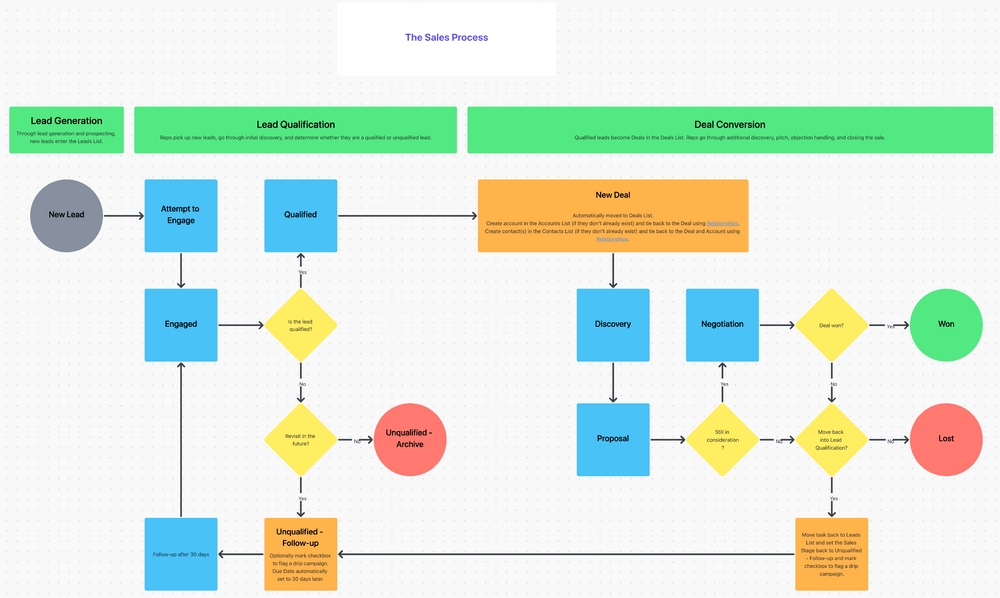
باستخدام ClickUp، ارسم خريطة لسير عملك ولا تفوت أي خطوة
استخدام أداة CRM الخاصة بك لـ أتمتة المهام المتكررة في سير عملك يعزز إنتاجية الفريق. فهو يضمن الاتساق ويقلل من الأخطاء ويوفر الوقت للتركيز على بناء العلاقات مع العملاء.
على سبيل المثال، حل إدارة علاقات العملاء مثل قالب خط أنابيب المبيعات الخاص ب ClickUp الذي يقوم بأتمتة خطوط أنابيب المبيعات وإدارة حسابات العملاء. يحتوي على نماذج مدمجة لجمع وتسجيل الردود من العملاء المحتملين الجدد تلقائيًا.
ومع دخول العملاء المحتملين إلى مسار المبيعات، يمكنك استخدام مشغلات الأتمتة لنقلهم عبر مراحل مختلفة. تُنشئ الأداة أيضًا تذكيرات وإشعارات لمهام المتابعة، بحيث لا يُترك أي عميل محتمل أو فرص معلقة. 💸
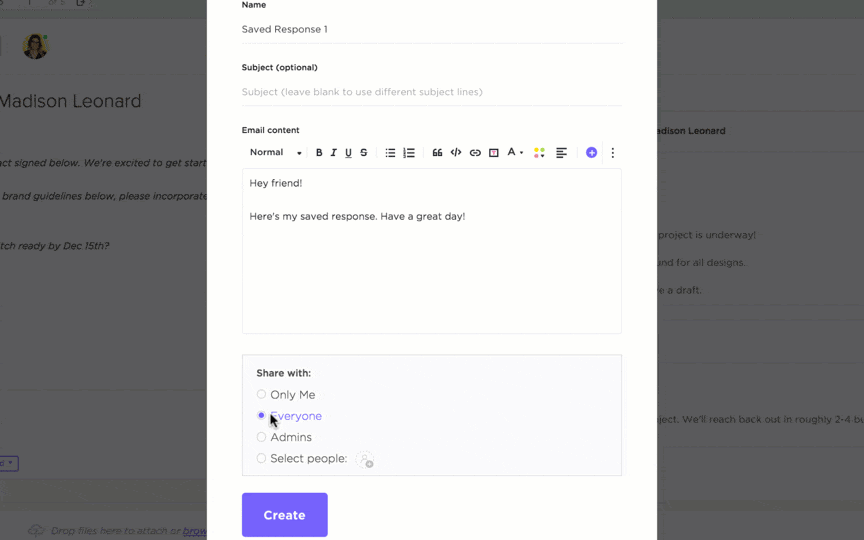
قم بإنشاء قوالب في ClickUp لأتمتة البريد الإلكتروني بشكل فعال لتقليل المهام اليدوية وتوفير الوقت أتمتة البريد الإلكتروني هو مكون رئيسي آخر لتصميم سير العمل الفعال. فهو يتيح لك رعاية العملاء المحتملين عن طريق إرسال رسائل بريد إلكتروني مستهدفة تلقائيًا تتوافق مع موقعهم في رحلة العميل.
من خلال إرسال المعلومات ذات الصلة في الوقت المناسب إلى العملاء المحتملين، فإنك تعزز فرص تحويلهم إلى عملاء مخلصين.
نصيحة احترافية على الرغم من أن التواصل عبر البريد الإلكتروني هو الأفضل لرعاية العملاء الحاليين وتحويل العملاء المحتملين، إلا أنه ليس مثاليًا للتواصل الداخلي. ضع في اعتبارك ما يلي بدائل البريد الإلكتروني لتحسين التواصل والتعاون في الوقت الفعلي داخل فريقك حتى يتمكنوا من خدمة عملائك بشكل أفضل.
7. تحديد الأولويات والتركيز على العملاء ذوي القيمة العالية
لتعزيز نجاح جهودك في إدارة علاقات العملاء، حدد عملاءك الأكثر قيمة وقم برعايتهم. هؤلاء هم العملاء الذين يساهمون بشكل كبير في إيراداتك ولديهم إمكانية إقامة شراكات طويلة الأجل.
بمجرد تحديد هؤلاء العملاء الرئيسيين، ركز على تقديم خدمة استثنائية واهتمام شخصي وعروض مصممة خصيصًا لتلبية احتياجاتهم وتفضيلاتهم الفردية. يمكن القيام بذلك من خلال:
- التواصل المنتظم: التواصل مع عملائك الرئيسيين من خلال رسائل البريد الإلكتروني المخصصة أو المكالمات الهاتفية أو الاجتماعات الشخصية. معالجة مخاوفهم، وتقديم تحديثات حول المنتجات أو الخدمات الجديدة، والتماس الملاحظات لضمان رضاهم
- مزايا حصرية: تقديم مزايا كعربون تقدير لولائهم. يمكن أن يشمل ذلك أولوية الوصول إلى الميزات أو الإصدارات الجديدة أو الخصومات أو العروض الترويجية الخاصة أو العروض المخصصة بناءً على سجل مشترياتهم
- الدعم الاستباقي: راقب أنماط استخدام هؤلاء العملاء. ثم تحديد المشاكل أو التحديات المحتملة التي قد يواجهونها، وتقديم حلول استباقية أو مساعدة استباقية قبل أن يطلبوا المساعدة 🙌
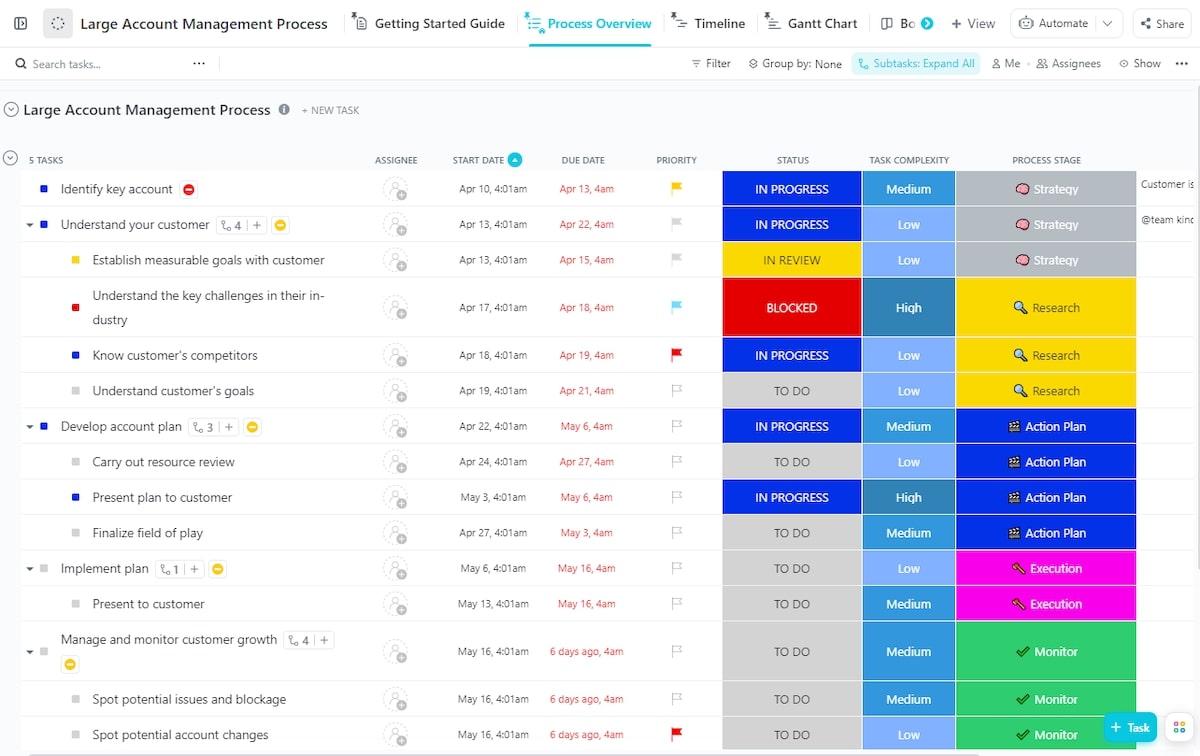
يفتح قالب ClickUp هذا فرص النمو من خلال مساعدتك على تحديد أهم عملائك وتحديد أولوياتهم
ليس من الضروري أن تكون إدارة العملاء ذوي القيمة العالية (الذين هم على الأرجح حساباتك الكبيرة) أمرًا مرهقًا للغاية. قم بتبسيط العملية باستخدام قالب عملية إدارة الحسابات الكبيرة ClickUp .
يتيح لك ذلك تخصيص الموارد اللازمة وتبسيط العملية. من خلال القيام بذلك، يمكنك تعزيز هذه العلاقات وضمان استمرار نموها.
8. تعزيز ثقافة التركيز على العملاء
لإنشاء ثقافة تتمحور حول العملاء في شركتك، عليك إشراك كل موظف في إعطاء الأولوية لاحتياجات العملاء وتقديم خدمة استثنائية. ويمكن تحقيق ذلك من خلال دمج المقاييس ذات الصلة في تقييمات الأداء وتقدير (ومكافأة) أعضاء الفريق عندما يتفوقون في هذا المجال.
تذكر أن كل تفاعل مع العملاء هو فرصة لتجاوز توقعاتهم وتعزيز ولائهم. ويعد إنشاء التزام على مستوى الشركة بالتركيز على العميل طريقة رائعة لخلق تجربة إيجابية لا تُنسى للعملاء في كل نقطة اتصال. تحقق من أدوات إدارة علاقات العملاء SaaS CRM !
9. تدريب فريقك ودعمه باستمرار
قم بتدريب فريقك لتعظيم قدرات أداة إدارة علاقات العملاء لديك وتقديم تجارب عملاء استثنائية. إلى جانب التدريب العام، استثمر في برامج متخصصة مصممة خصيصًا لأدوار محددة.
على سبيل المثال، يمكن أن يستفيد فريق المبيعات وفريق التسويق لديك من التدريب على تقنيات إدارة العملاء المحتملين، بينما يمكن لفريق خدمة العملاء تلقي تدريب متخصص على حل التذاكر بفعالية.
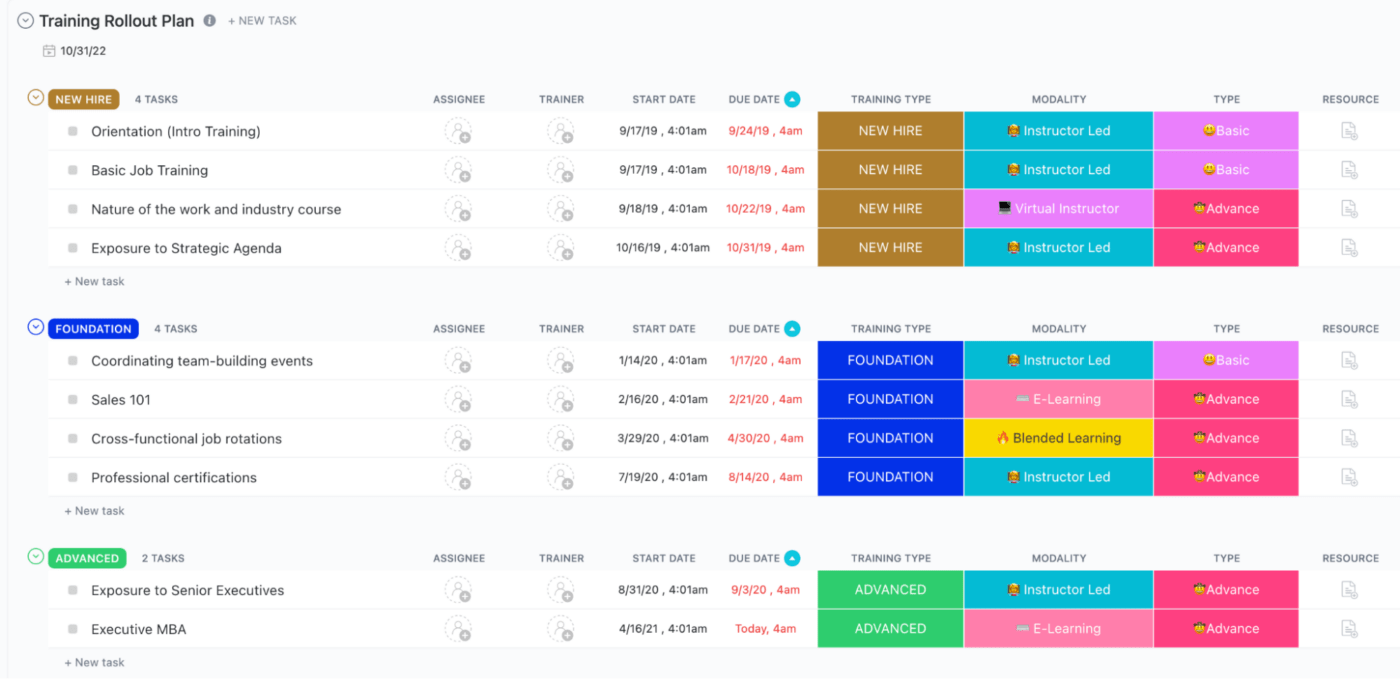
قالب خطة طرح التدريب من ClickUp
يمكن للمدربين وقادة الموارد البشرية استخدام خطة طرح التدريب ClickUp لضمان التنفيذ السلس والفعال لجهود تدريب الفريق. ⚡️
بالإضافة إلى ذلك، قم بتعزيز بيئة التعلم المستمر - قم بتنظيم ورش عمل أو ندوات عبر الإنترنت أو جلسات لتبادل المعرفة حيث يمكن لأعضاء الفريق تبادل الأفكار وقصص النجاح المتعلقة باستخدام إدارة علاقات العملاء وعملياتها. يشجع هذا النهج التعاوني على النمو واعتماد أفضل ممارسات إدارة علاقات العملاء.
10. تقييم وتكييف بانتظام
يعتمد نجاح استراتيجية إدارة علاقات العملاء الخاصة بك على التقييم والتعديل المستمر. لذلك راقب عن كثب أهدافك ومؤشرات الأداء الرئيسية (مع تقارير مؤشرات الأداء الرئيسية القابلة للتنفيذ ) لقياس تأثير استراتيجية إدارة علاقات العملاء الخاصة بك.
انظر إلى مشاركة العملاء ومعدلات التحويل ونتائج رضا العملاء لفهم مدى نجاح استراتيجيتك. يجب عليك أيضًا جمع التعليقات من أعضاء فريقك وعملائك، وتحديد المجالات التي يمكن إجراء تحسينات فيها، وتنفيذ التغييرات وفقًا لذلك. ✔️

يتيح لك ClickUp البدء في استخدام مجموعة متنوعة من استراتيجيات إدارة علاقات العملاء
تتطور احتياجات العملاء واتجاهات السوق باستمرار، لذلك من المهم أن تظل على اطلاع دائم على آخر المستجدات وأن تكون متجاوبًا مع هذه التغييرات. يتيح لك ذلك إجراء تعديلات استباقية على استراتيجية إدارة علاقات العملاء الخاصة بك، مما يضمن بقاءها ملائمة ومؤثرة.
إلقاء نظرة على هذه برامج إدارة علاقات العملاء للشركات الخدمية !
تعزيز العلاقات مع العملاء ودفع نمو الأعمال باستخدام استراتيجيات إدارة علاقات العملاء القوية
من خلال دمج هذه الاستراتيجيات العشر المثبتة والقابلة للتنفيذ، يمكنك تحسين إنتاجية فريق العمل، وتعزيز العلاقات مع العملاء، ورفع الأرباح، وزيادة الربحية الإجمالية في عملك.
يمكن أن تساعدك ميزة إدارة علاقات العملاء في ClickUp على تبسيط سير عملك داخليًا وخارجيًا. من إدارة جهات الاتصال وأتمتة المهام إلى التحليلات وقدرات التكامل، فإن ClickUp لديه كل شيء.
ابدأ العمل الآن مع خطة ClickUp المجانية .

